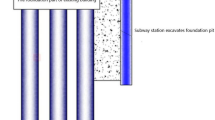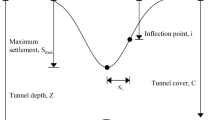The determination of surrounding rock or soil pressure is a prerequisite for tunnel excavation and lining. In this study, theoretical calculations are combined with on-site monitoring of the soil pressure of the Jinci tunnel as a case study. The soil pressure results obtained by both methods are compared and analyzed. Depth is found to significantly influence both the failure mode and soil pressure. The Jinci tunnel has grade-V surrounding soil. The vertical soil pressure obtained by the theoretical calculations is 11.3% greater than the measured value. The calculated value is highly reliable and can be used for the design load of tunnel-lining structures. The calculated horizontal soil pressure is 23.3% lower than the measured value owing to the effects of horizontal tectonic stress and soil anisotropy. The findings provide a method to determine the soil pressure of tunnels and serve as a useful reference for similar projects.
Similar content being viewed by others
References
H. F. Qu, Zh. C. Yang, and H. H. Zhu, “Research and development on surrounding rock pressure of road tunnel,” Chin. J. Undergr. Sp. Eng., 3 (3) 536-543 (2007).
M. M. Farias and A. H. Moraes, “Displacement control in tunnels excavated by the NATM 3-D numerical simulations,” Tunn. Undergr. Sp. Tech, 19 (3) 283-293 (2004).
S. C. Hsu, S. S. Chiang, and J. R. Lai, “Failure mechanisms of tunnels in weak rock with interbedded structures,” Int J Rock Mech Min Sci, 41 (3) 670-675 (2004).
R. K. Goel, J. L. Jethwa, and A. G. Paithankar, “Indian experiences with Q and RMR system,” Tunn. Undergr. Sp. Tech, 10 (1) 97-109 (1995).
X. T. Mo, “Study on surrounding rock stand-up time and primary support load,” PhD dissertation, Beijing Jiaotong University, Beijing (2001).
I. K. Ghaffari and H. Shahir, “Analytical solution for active earth pressure of c-φ soil considering arching effect,” Geomech. Geoengin., (14) 1-14 (2018).
A. Pain, Q. Chen, and S. Nimbalkar, “Evaluation of seismic passive earth pressure of inclined rigid retaining wall considering soil arching effect,” Soil. Dyn. Earthq. Eng., (100) 286-295 (2017).
B. Junied and A S. Mohd, “A finite element performance-based approach to correlate movement of a rigid retaining wall with seismic earth pressure,” Soil. Dyn. Earthq. Eng., (114) 460-479 (2018).
A. G. Chermahini and H. Tahghighi, “Numerical finite element analysis of underground tunnel crossing an active reverse fault: a case study on the Sabzkouh segmental tunnel,” Geomech. Geoengin., 14 (3) 155-166 (2019).
M. A. Patki, J. N. Mandal, and D. M. Dewaikar, “A simple approach based on the limit equilibrium method for evaluating passive earth pressure coefficients,” Geotechnik, 38 (2) 120-133 (2015).
Y. M. Cheng, “Seismic lateral earth pressure coefficients for c-φ soils by slip line method,” Comput. Geotech., 30 (8) 661-670 (2003).
S. Li, L. Ma, and Q. C. Wang, “Model tests and numerical simulations of earth pressure for unloading structures of high fill open cut tunnel,” Chin. J. Geotech. Eng., 38 (4) 636-642 (2016).
Y. Taguchi, H. Yoneyama, and H. Sasao, “Model Tests for earth pressure acting on pre-lining tunnel,” J. Jpn. Soc. Civil. Eng., (631) 151-160 (2010).
K. Najm and Y. Ishijima, “Back analysis of tunnel lining deformation: development and application of passive resistance method,” Rock Mech. Rock Eng., 26 (1) 71-79 (1993).
O. P. Alekseenko and A. M. Vaisman, “Direct measurement of rock pressure in mine conditions by hydraulic fracturing method,” J. Min. Sci., 39 (5) 475-481 (2003).
N. R. Barton and J. L. Lien, “Engineering classification of rock masses for the design of tunnel support,” Rock Mech., 6 (4) 189-236 (1974).
B. Singh and R.K. Goel, Engineering Rock Mass Classification, Kidlington, Butterworth-Heinemann (2012).
China Railway Eryuan Engineering Group CO. LTD, Code for Design on Tunnel of Railway TB10003, China Railway Publishing House, Beijing (2016).
W. Q. Ding, X. X. Wang, and H. H. Zhu, “Defining method for designing load of multi-arch tunnel,” China J. Highw. Transp., 20 (5) 78-82 (2017).
Author information
Authors and Affiliations
Corresponding author
Additional information
Translated from Osnovaniya, Fundamenty i Mekhanika Gruntov, No. 1, January-February, 2022.
Rights and permissions
About this article
Cite this article
Du, Y., Fu, S. & Zhao, Y. Theoretical Calculations and Field Measurements of the Earth Pressure in the Jinci Tunnel. Soil Mech Found Eng 59, 77–84 (2022). https://doi.org/10.1007/s11204-022-09786-8
Published:
Issue Date:
DOI: https://doi.org/10.1007/s11204-022-09786-8




